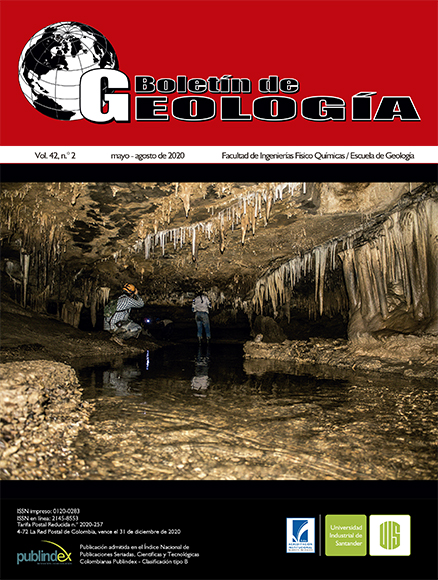Methodology and application of seismic attributes in modeling facies for potentially gas producing areas. Santa Cruz-Jibacoa oilfields area, Cuba
Published 2020-05-28
Keywords
- Lithofacies,
- Seismic attributes,
- Cuban Northern Oil Belt,
- Geostatistics,
- Data mining
- Exploration risk ...More
How to Cite
Altmetrics
Abstract
Historically the Cuban exploration strategy has been characterized by discovering productive oil intervals and to use its associated gas by conventional methods. The objective of this study was to create a methodology to detect reservoirs with free gaseous hydrocarbons contain, by seismic attributes. Were chosen two oilfields located in the Cuban Northern Oil Belt; (main Cuban oil region); Santa Cruz del Norte (learning pattern) and Jibacoa oil fields (predictive pattern). Were studied the Vega Alta Formation, a synogenic sequence of Paleocene-Middle Eocene age, with great lithological complexity and considered as a regional seal, but paradoxically, with significant hydrocarbons presence. A microfacial analysis was carried out, with the information of the cuttings, building a ternary model for clastite rocks and another model for carbonated and siliceous rocks. Were studied 1921 m by cuttings samples, predominantly clastic lithofacies. An exploratory data analysis was carried out, which permitted obtaining information about the unknown relationship between lithofacies and seismic attributes. The seismic signatures of lithofacial classification were determined, and with the assistance of data mining methods were adjusted the seismic attributes to differentiate lithofacies. These were discretized in 4130 standard patterns intervals. Probability values were calculated applying a geostatistics sequential simulation algorithm. The inverse task (conversion of seismic attributes to lithofacies) was executed, through a supervised classification, into a 350000 cells matrix (approximately 43750 km3), with the selected seismic attributes and finally, an exploration risk analysis was calculated for estimate the economic strategy.
Downloads
References
Chopra, S.; Marfurt, K.J. (2007). Seismic Attributes for Prospect Identification and Reservoir Characterization. Society of Exploration Geophysicists. Geophysical Development Series. No. 11.
Daber, R.; Aqrawi, A. (2010). Interpreter’s Guide to Seismic Attributes. Houston: Schlumberger Limited.
Folk, R. (1980). Petrology of sedimentary rocks. Austin: Hemphill Publishing Company.
Gómez-Herrera, J.; Rodríguez-Morán, O. (2013). Metodología para el análisis del riesgo petrolero y toma de decisiones. Caso de estudio Franja Norte de Crudos Pesados, sector Guanabo-Seboruco, Cuba. Anuario de la Sociedad Cubana de Geología, 1, 23-31.
Hernández, J. (2015). Proyecto 7043. Etapa 3. Bioestratigrafía de los depósitos de los sellos en Cuba occidental. Archivo Técnico del Centro de Investigaciones del Petróleo. La Habana, Cuba.
Hernández, J. (2018). Proyecto 7082. Exploración de gas en Cuba. Archivo Técnico del Centro de Investigaciones del Petróleo. La Habana, Cuba.
Hernández-Orallo, J.; Ramírez-Quintana, M.; Ferri-Ramírez, M.J. (2004). Introducción a la Minería de Datos. Madrid: Pearson Educación, S.A.
Martínez, R.; Valdez, J. (2011). Cálculo de reservas en yacimientos de gas. Tesis, Universidad Nacional Autónoma de México, México.
Morales, C. (2014). Proyecto 7078. Exploración en el sector Morro - Boca de Jaruco en la Franja Norte de Crudos Pesados. Archivo Técnico del Centro de Investigaciones del Petróleo. La Habana, Cuba.
Pettijohn, F.J. (1975). Sedimentary rocks. 3ra edición. New York: Harper & Row.
Pyrcz, M.J.; Deutsch, C.V. (2014). Geostatistical reservoir modeling. Oxford University Press. 2nd Edition.
Taner, M.T. (2001). Seismic Attributes. CSEG Recorder, 26(7), 48-56.
Weka. (2018). Waikato environment for knowledge analysis. Version 3.9.3. Waikato University. New Zealand. https://www.cs.waikato.ac.nz/ml/weka/

